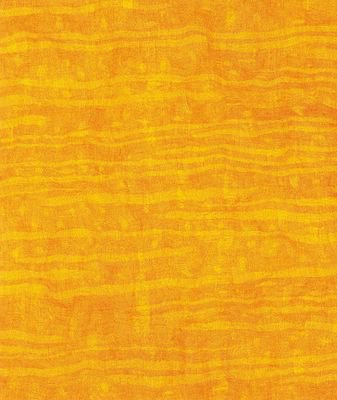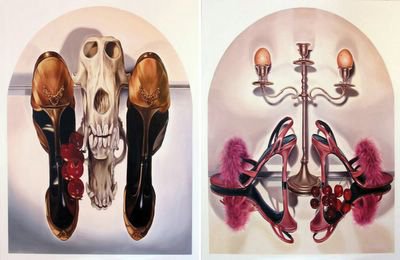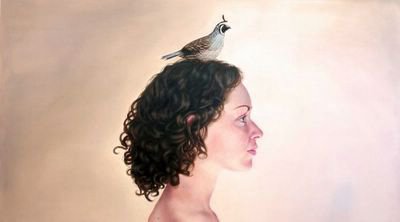Sometimes it’s good to be shown something. Instead of artists demonstrating how clever, how erudite, how flippin’ learned they are, it’s good see some skills laid out end to end. The King Street Gallery is a place you can go to see paint on canvas. It’s like visiting your parents on the weekend – you leave with a full stomach and a confident attitude, like you’ve done the right thing. We were heading down the hill and noticed the work of John Bokor hanging in the window of KSG. For a moment we thought the painting was by Wendy Sharpe – we were on the other side of the road – and tonally Bokor’s work is kind of drab, post war figurative painting heavy on the Worcestershire sauce that Sharpe has been doing since she gave up cadmium red.

John Bokor, Still life with striped green tablecloth, 2005. Oil on board 50x60cm.
But once over the zebra crossing and up close, it was plain that these two artists couldn’t be more different. Sharpe is an artist for whom the stroke is everything and you can see that she builds up a picture gesturally. Bokor, by the look of the work, builds his pictures up in blocks, almost sculpting the pictures from slabs of paint assembled from a kit. The works in his show at KSG are so solid you could build a house on them. It should be no surprise that Bokor paints charming, Sunday-painter-esque scenes of life around the inner city – terrace houses, back yards, still lives. There are a couple of still lives in the show [until November 12] that are lovely, but for a guy who is barely into his 30s, such dowdy old lady subject matter is perplexing. This choice of solid subject probably comes from the artist’s education at the National Art School across the road from KSG – an institution that teaches its pupils to worship the brush and fear the video projector. Look to your palette boy! Eyes down! Either that or he drinks ponies of New and punts on the doggies.
There are no such thoughts about Karl Wiebke. He is a man who paints precisely, laying down every stroke with deliberation, purpose and direction. Looking at the reproduction of his work on the gallery invitation or on the Liverpool Street Gallery [which, confusingly, is on Liverpool Street] you’d be forgiven for thinking, as we did, that his paintings were swatches of fabric mounted on a stretcher. Back in the late 80s when Wiebke exhibited at EMR, he was doing small scale abstracts using collage and paint – so it wasn’t out of the question that the artist had done a similar thing now. But just take a look at the work below – this is a canvas 212cm by 178cm where each line has been applied with a No.1 brush, following the grain of the canvas, each valley and rise in the fabric guiding a series of lines. It is mind blowing and we fear for the artist’s eye sight.

Karl Wiebke, 30 – 04 red on yellow, 2005. Acrylic on Belgium linen, 212 cm x 178 cm.
As an artist who creates paintings that follow a methodology, Wiebke’s paintings are simply incredible. Aside from whatever you want to say about the materiality of painting, or of how these works are the result of a conceptual practice, the encapsulation of time within them is staggering. Like Indigenous dot paintings, these canvases are a testament to hours of work and yet, despite the long term project of making them, they are not weighed down by worthy craftsmanship. The only other artist whose work contains such a seemingly effortless grace is Alan Mittleman, but we doubt that he spends 18 months on six canvases. Last year Wiebke exhibited at LSG a series of works that he’d done by leaving the canvases outside for up to seven years, every now and then adding a new layer of oil paint to sit and curdle in Melbourne’s crazy weather. One could respect the exacting practice of pursuing such a relentlessly long process, but by the end, the work was a testament to an idea, and as such, it was something that you appreciated rather than liked.
The amazing by-product of the artist’s methodology in this 2005 show is that he has also created a series of extraordinarily beautiful paintings. Where many of the younger generation of conceptual abstractionists are capable of making a visually pleasing work – and whose methodology, if anything, is even more exacting than Wiebke’s – they are usually incapable of stepping beyond the project and the materials. We’re not sure if the artist set out to make an aesthetically beautiful object from his work, but it is something he’s achieved anyway.

VR Morrison, Objets de luxe I & II, 2005. Oil on linen, 116x89cm each.
Showing at Sullivan & Strumpf is the work of VR Morrison, a painter from Brisbane who is now living in France. We don’t know much about the artist’s older work, but her huge picture that was hung in the gallery’s opening group show displayed a formidable talent for painting in oils at scale in a polished photographic style that’s hard to master. That her painting also freely quoted from Caravaggio and Artemisia Gentileschi was no bad thing. She also paints from photographic studies but where many artists come a-cropper with squashed perspectives, her work seems to exist in an eerily limited third dimension. This is why, we think, her nickname is “Virtual Reality” Morrison, a reference to the fact that her works have a queasy sur-reality that is as demanding as it is shocking.
In her past work, Morrison had gone to town with chiaroscuro lighting for her big effects, but in this latest show she’s gone for a flat, direct lighting that paradoxically adds further theatrical oompah to her already disturbing tableaux. Apparently the artist is a fan of the French school of David, and you can see within Morrison’s works the same kind of neo-classical compositional values. But Morrison’s women couldn’t be taken as authentic historical figures – there’s no mistaking that these are contemporary pictures and that these are contemporary people. Morrison is also fond of mirroring in the work – in one pair of paintings a woman faces herself in almost identical pose. In one picture she’s got a bunch of grapes, in the other she has a jug of wine that has spilled on to an exquisitely rendered cloth. Well, there you are – transformations and reflections.

VR Morrison, Liberte Egalite Gastronomie, 2005. Oil on linen, 85x150cms.
This pictorial idea is elaborated in a highly ornate pair of paintings called Objects I and II, and Morrison edges dangerously close to Salvador Dali territory. A much more subtle and amusing approach to the idea is Liberté, egalité, gastronomie in which a woman uses a quail as a hat. On one level, we can appreciate the intense craftsmanship of the works, and yet on the other – we are truly afraid. Morrison’s figures seem to be acting against a backdrop and their steely gaze – when they are looking at the viewer – is simply unnerving. What we wanted was to move beyond this claustrophobic world and into a space beyond the backdrop. Both Dali and David used the long shadows of architecture and landscapes to add more weight to their foreground actors and it’s a space that Morrison needs to explore.
Runway is on to its sixth issue, this latest themed around ‘watching’. For $12 you get the handsomely produced magazine and for the first time a DVD of artist’s video works. If you can think of better value for money than that, then we’d like to hear about it! This is the way video art should be viewed – in the comfort of your own home, without the discomfort of the gallery and the need to wear crummy headphones while perched on a bean bag. If only all art could be so portable. The DVD contains 10 short video pieces, the longest at eight and half minutes, and features some names that’d be familiar to anyone who travels the byways of the Sydney artist run galleries – Ms. & Mr, Emma White, Rebecca Ann Hobbs, Arlo Mountford, Rachel Scott, Bianca Barling, Kate Murphy, Soda_Jerk & Sam Smith, Penny Cain and John Harris. We wouldn’t go so far as to say there’s something here for everyone because the work is very much within the genres of video art and film making, but the selection is pleasingly wide.

The Pheonix Portal, Soda_Jerk & Sam Smith.
Our favourite works on the DVD are Emma White’s Managing Processes: Part One – Applying Methodologies and The Phoenix Portal by Jerk and Smith. White’s piece is a very funny and well done parody of art institutions and the video purports to explain the way the institution works – from people laboring in the lab to the middle management curators pulling the whole thing together. We won’t spoil it for you by revealing what this institution does, but it’s a sly choice that adds a commentary to the way art and meaning are created through institutionalised processes. Our favourite moment in the piece is where a hand comes through a doorway with one of those public service envelopes – it was a horrible flash back to the Ministry of The Arts.
White’s video is charmingly rough, much like a low budget documentary you might see at the Dendy Awards or on SBS but The Phoenix Portal is about as sophisticated a piece of video making as we have ever seen. That’s not a hyperbolic claim because what the artists have achieved with this work is a seamless sampling of two films starring River Phoenix, editing them together and creating a new soundtrack from what looked like about a dozen music sources. The work is flawless in its execution. That it also has a brilliant SF idea attached to it is remarkable. We’ve heard that Smith is the guy you go to to make technically proficient videos and Soda_Jerk are well known for their big ideas. Together, it’s a ménage a trois made in heaven. Mention should also be made of Rachel Scott’s I’m Waiting For My Real Life To Begin which has the unique quality of starting off brilliantly, getting boring in the middle, before becoming a masterpiece at the end.
